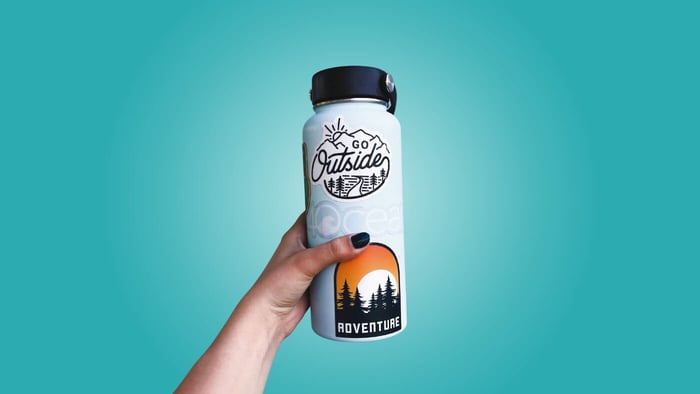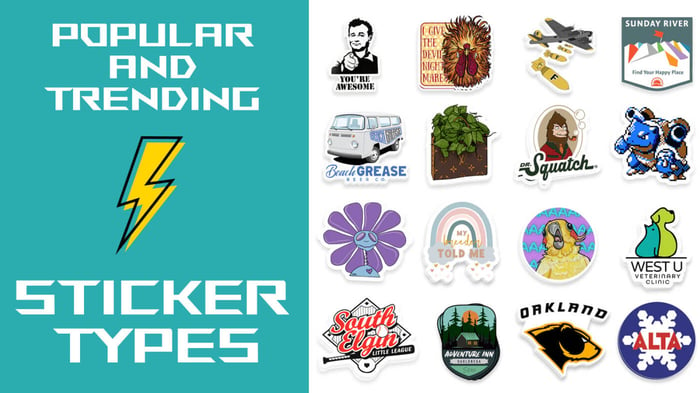Stickers, decals, and labels can be easily confused, as people tend to use these terms interchangeably. To help you understand the difference between them, we will break down their definitions and uses so that you can make informed decisions when selecting the perfect adhesive product for your project.
Stickers, Labels and Decal Differences
Breaking Down the Definitions
Let's start by referring to the New Oxford Dictionary definitions:
- Sticker: An adhesive label or notice, generally printed or illustrated.
- Label: A small piece of paper, fabric, plastic, or similar material attached to an object and giving information about it.
- Decal: A design prepared on special paper for transfer onto another surface such as glass, porcelain, or metal.
As you can see, stickers can be considered a type of label, and labels with an adhesive are also stickers. But where do decals fit in?
Stickers: Heavy-Duty Use

At Custom Stickers, we use the term "sticker" for more heavy-duty adhesive products that are designed for outdoor use and can withstand the elements for an extended period of time. These are typically printed on vinyl material with durable outdoor inks, and a UV laminate that gives the stickers a 5+ year lifespan, even outdoors.
Examples of stickers include:
Labels: Indoor Adhesive Products

We generally use the term "label" for adhesive products printed on paper or foil with inks that are not suitable for outdoor use. These labels are typically supplied on a roll or sheet and are used indoors for various purposes, such as:
We can laminate labels for added durability, but they are still intended for temporary use and won't hold up for years like vinyl stickers.
Decals: Transfers for Decoration

The term "decal" is often used interchangeably with other outdoor sticker products. However, decals are more closely associated with a "transfer" from one medium to another. "Decal" is short for "decalcomania" and is usually used for more decorative designs.
Examples of decals include:
More About Vinyl Cut Decals
The confusion between stickers and decals often arises from vinyl cut lettering and graphics. These adhesive products are designed for long-term outdoor use and are supplied with a pre-masking sheet. Upon application, the vinyl is transferred from the masking sheet to a smooth surface.

These vinyl decals are often referred to as "decals" and "vinyl cut stickers" interchangeably, as they combine elements of both stickers and decals.
Making the Right Choice: Sticker, Label, or Decal?
Now that you understand the differences between stickers, labels, and decals, it's important to consider your specific needs when selecting the right adhesive product.
- Stickers: Choose stickers for heavy-duty, outdoor applications that require durability and weather resistance.
- Labels: Opt for labels when you need indoor adhesive products for packaging, paperwork, clothing, or other indoor uses.
- Decals: Select decals for more decorative purposes, or when transferring a design from one medium to another is essential.
As you evaluate your options, consider the following factors:
- The intended use and environment for the adhesive product
- The desired durability and longevity of the product
- The material and surface to which the adhesive product will be applied
Tips for Applying Stickers and Decals

To ensure a successful application of your chosen adhesive product, follow these tips:
-
Clean the surface: Before applying a sticker or decal, thoroughly clean the surface to remove any dust, dirt, or oils that may interfere with adhesion.
-
Apply on a smooth surface: Both stickers and decals adhere best to smooth, non-porous surfaces. Avoid applying them to rough or textured materials.
-
Remove air bubbles: When applying a sticker or decal, gently press from the center outward to eliminate any air bubbles trapped beneath the adhesive.
-
Allow time for curing: Once applied, give the adhesive product ample time to cure and fully bond to the surface. Avoid touching or moving the sticker or decal during this time.
Caring for Your Stickers and Decals
Proper care can extend the life of your adhesive products and keep them looking their best. Follow these maintenance tips:
-
Clean gently: When cleaning around stickers and decals, avoid using abrasive materials or harsh chemicals that may damage the adhesive or printed design.
-
Protect from sunlight: Prolonged exposure to direct sunlight can cause colors to fade over time. If possible, position your stickers and decals in a shaded area or apply a UV-resistant coating for added protection.
-
Monitor wear and tear: Regularly inspect your adhesive products for signs of wear, such as peeling edges or fading colors. Replace them as needed to maintain their appearance and effectiveness.
In Conclusion: Stickers, Labels, and Decal Differences

Understanding the difference between stickers, labels, and decals is essential when choosing the right adhesive product for your needs. By considering the intended use, durability, and application surface, you can confidently select the perfect solution for your project.
Whether you're looking to label, decorate, or promote, remember that the right adhesive product can make all the difference. And, if you're ever unsure, consult with a manufacturer or expert to ensure you're making the best choice for your specific requirements. With a little knowledge and creativity, the possibilities are endless!





